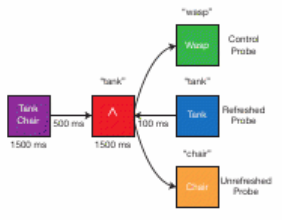cog psych; week 1; working memory: models and theory
1/70
There's no tags or description
Looks like no tags are added yet.
Name | Mastery | Learn | Test | Matching | Spaced |
|---|
No study sessions yet.
71 Terms
working memory
storage and processing of information in the present moment
flexible workspace = working memory
The ability to hold goal-relevant information in mind (active state) for ongoing task... in the physical absence of this information
There are many times like this on a day where we need to hold information in mind. Usually briefly and for a ongoing task in the physical absence of this information. We don’t have the sensory information in front of us. This can be thought as an ability. Working memory is at the core of cognition, acting as a flexible workspace on which thoughts can be held, manipulated, and used to guide behaviour.
flexibility.
We hold anything we want in working memory – make arbitrary relationships between items = flexibility.
We cannot hold too much information in working memory – we are limited in this ability.
WM vs LTM
WM: Active (easily accessible) Relevant to goal/task, Immediate use, Limited capacity
Remote (needs to be cued), Everything learned/remembered, Permanent(ish), Unlimited
The multicomponent model
hierarchical organisation
multiple components with functional responsibilities
interaction of attention, LTM with present stimuli
central executive
coordination of storage systems and control of attention to stimuli
tells other components what to do
phonological loop
separate storage of visuospatial and auditory information
auditory/ linguistic input (text) → phonological short-term store ←> subvocal rehearsal (articulatory loop)
visuospatial sketchpad
taste/olfaction - touch/haptics not formal components
episodic buffer
binding of multimodal information to form episodic memories
transfer of information between WM and LTM
Word length effect
bilingual English/ Welsh speakers can recall more English than Welsh digits, and Welsh digits have a longer spoken duration.
Chinese→ Better Chinese digit span, Chinese digit have a short spoken duration
language can have a profound impact on memory
WLE and articulatory suppression
Articulatory suppression – the uttering of an irrelevant word ‘the, the, the’ whilst being presented with words to remember.
Baddeley et al. (1975)
Articulatory Suppression abolishes the word-length effect with visual presentation -> participants can’t transform words into phonological codes
Word-length effect not abolished with auditory presentation presumably as words enter straight into the phonological store.
Suggests that suppression occupies the articulatory control processes (for visual presentation) but does not prevent direct access to phonological store (for auditory presentation).
Phonological similarity effect
Phonological similarity effect (Conrad, 1964; Baddeley, 1966, Baddely et al., 2018)
The tendency for recall to be depressed where the items ‘sound’ similar in working memory. (Baddeley, 1966)
Semantic Similarity - Words that are similar in meaning have no impact on working memory.
LONG, TALL, WIDE, GREAT, HUGE, BIG, BROAD
Suggests coding is Phonological
The multi-component WM model
Highly influential theory of WM
Large body of evidence in support of individual components
However, not without its issues
Let’s examine some of the assumptions and problems
The multicomponent model assumptions
Central Executive → flexible allocation of attention
storage systems→ domain-specific short-term storage
Episodic Buffer→ Binding of information from difference sources
The multi-component model assumption → problem
CE→ flexible allocation of attention → The central executive is a homunculus: a critical part of the model that is not explained any further.
EB→ Binding of information from difference sources → Do we really need two separate memory systems (i.e. long-term and working memory)? Occam’s razor: Explanations with fewer assumptions are preferred.
SS→ domain-specific short-term storage → Do we really need two separate, domain-specific storage systems? let’s test!
Two Key assumptions follow:
If 2 tasks use the same component, they cannot be performed successfully together
If 2 tasks use different component, they can be performed as well together as separately.
Dual Task studies
Robbins et al. (1996)
Chess players selected continuation moves from chess positions while carrying out other tasks:
Repetitive tapping (control)
Articulatory Suppression (“see saw” - phonological loop)
Random letter generation (central executive)
Pressing keys in a clockwise direction (Visuo-spatial sketchpad)
Performance on chess task (score) significantly worse for concurrent use of VSS or CE
Consistent with assumptions of the multi-component model
Testing domain-specificity:
Complex span task to assess storage and processing of information, using a memoranda
Testing domain-specificity: Combine verbal and visuo-spatial materials to compare same-domain to different-domain performance
verbal - verbal → same-domain
verbal - visuo-spatial → different-domain
visuo-spatial - visuo-spatial → same-domain
visuo-spatial - verbal → different domain
verbal storage → would be something like letters, numbers, (non)words
visuo-spatial storage → would be something like location/position on a grid, shapes, patterns
verbal processing → decisions about equations, lexicality, rhyme
visuo-spatial processing → decisions about symmetry, orientation, identity
Domain-specificity would predict lower recall performance for same-domain combinations than for different-domain combinations.
Vergauwe et al’s experiments (2022)
rationale → Previous studies used task combinations that varied in more aspects than just the representational domain (e.g., response modality required – responding outloud in visual spatial task (verbal) clicking with a mouse in a verbal task (visual spatial)). This confound might have affected the results.
method → verbal storage (auditory nonwords) → verbal processing (rhymes? using actual letters, had to make a decision as to whether or not the noises rhymed), assess response
results →
Under assumptions of multi-modal model - performance should suffer - same resource/domain
Both require phonological loop
No difference between same-domain and different-domain combinations.
Speaks against need for two separate storage systems.
A single study is not enough; the jury is still out on this!
Activation based models
Cowan’s (1995) embedded-processes model
activated part of long-term memory
focus of attention (current contents of WM)

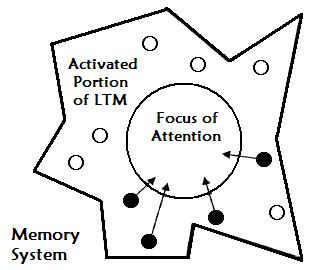
Working memory - not a separate entity
Part of long-term memory
Focus of attention - approx 4 items
Central executive still directs attention
5 Principles:
WM information comes from hierarchically arranged facilities comprising a) LTM, b) subset of LTM that is currently activated, c) the subset of activated memory that is the focus of attention (FOA)and awareness
Processing limits are different LTM, active LTM and FOA
The FOA is controlled jointly by volitional processes (central executive) and involuntary processes (attentional orienting system)
Stimuli that are not important or changing remain active but do not elicit awareness
Awareness influences processing - allows for explicit recall
Working memory holds “a limited amount of information temporarily in a heightened state of availability for use in ongoing information processing” (Cowan, 2017, p. 1163).
Working memory is a subset of representations in long-term memory, not a separate system.
Example: birth year was in an activated state.
Cowan’s (1995) embedded-processes model- complex span test
the way this works in regards to our complex span task, is that we are given the letters to remember and a distractor to do as you go. When given the letter, we already have long term memory concepts of them, which gets activated, and become focuses of attention. This issue is what if you want to manipulate one of the items individually, how do we do this? Cowan’s model does not give a good account of this necessarily. A new model has adapted to this.
Oberauer’s (2009) three-embedded components model
Adds onto Cowan’s activation model, with an added element →
Narrow focus of attention
One currently selected representation
Narrow focus of attention explains how individual elements are selected for processing and manipulation
Activated part of long-term memory
Broad focus of attention
“region of direct access” to representations bound to the current context
sharing up to four items relatively related to the context
Evidence for the Broad Focus of Attention and Activated LTM
Modified Sternberg task- two cues - Two probe recognition paradigm
participants are given 2 lists to study, the list can avry in size (1-3) and is colour coded, then shown a probe (one of the words in the list or not), they have to decide whether the word was in the list or not
First cue: Tells participants which list is relevant for the first probe
First probe: Participant must decide if this was present in the relevant (i.e. red) list
tower was in green so this would need to be rejected by the participant
Second cue: Tells participants which list is relevant for the second probe
Second probe: Participant has to decide whether the second probe was in the relevant (i.e. green list) in this case, Fish was - so this would be accepted
I.V. - Cue Probe Interval - how long items remain in broad focus of attention and activated LTM- 100ms - 2000ms
Relevant and irrelevant list length (1 - 3 items)
D.V. - RT to reject/accept items
At short intervals set size of both lists (relevant and irrelevant) affects RTV
Increase in RT from irrelevant set size 1 - 3 and relevant 1 - 3
At longer intervals only the size of the relevant set affects RT
Respond quicker to smaller relevant set size (1)
Findings suggest within 1 - 2 seconds, irrelevant list is removed from broad focus
BUT - remains active in long term memory
Rejecting probes from irrelevant list - harder than new words
Also!
When second probe indicates previously irrelevant list is now relevant - participants can respond accurately
Suggest broad focus of attention can flexibly shift from 1 set of stimuli to another
Broad focus provides a candidate set of items
Increasing items leads to slower access due to interference (more on this next week)
Info outside broad focus can be maintained in activated LTM
You can outsource information to active LTM and retrieve it back later if needed
Evidence for the narrow focus of attention
Sternberg (1966) recognition paradigm shows last item studied has a special status in WM (McElree & Dosher, 1989)
R, B, K….
Last item held accessible at higher rate than any other item from list - consistent with being held as the NFA
Object Switch Paradigm (Garavan, 1998)
Participants keep a running total of objects being presented (Triangles versus Squares)
On Each trial - update previously updated count (i.e Triangle -> Triangle) Or Switch count (Triangle -> Square)
DV in speed of response for each count
Switching from one count to another results in Switch Cost
Consistent with the narrow focus of attention shifting from one count to another
Repetitions result in faster response (repetition benefits)
Activation based models
Compensate for some of the assumptions of the multicomponent model
CE - Homunculi
Separation of LTM and WM
Role of attention
Domain Specificity
Developing research and model
Still questions to be answered
BADDELEY’S MULTICOMPONENT THEORY
For this theory, working memory is made up of several components: (1) the phonological loop, (2) the visuospatial sketchpad, (3) the episodic buffer, and (4) the central executive.
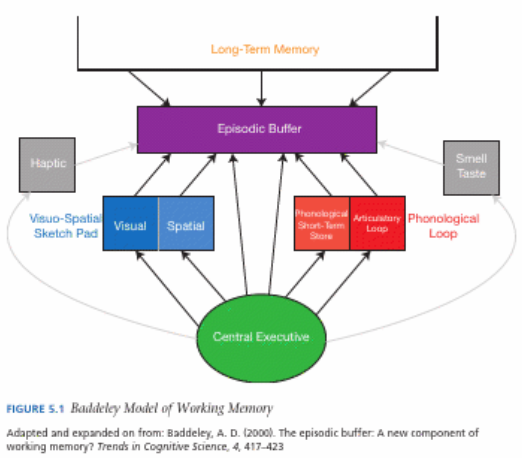
The phonological loop, visuospatial sketchpad, and episodic buffer are specialized subsystems under the control of a generalized executive controller, which runs the operation. Note that there are some bits in grey in that are not formal parts of the model but that are likely to be involved at some level.
The phonological loop, visuospatial sketchpad and the episodic buffer comparison
The phonological loop and visuospatial sketchpad are relatively separate- different types of information tend to not influence each other, but there is interference if two tasks use resources from the same part of working memory.
Cross-system deficits occur when executive controller processes are affected, like when the tasks involve large memory loads.
The central executive has additional capacity, which it can devote to a subsystem if the demands become taxing. For example, thinking about a difficult problem while walking, you may stop walking because the visual-spatial part of working memory for navigation has some resources taken away by the central executive to be used elsewhere. The central executive is to regulate the flow of information in the current stream of thought as a supervisory attentional system
phonological loop
The phonological loop has received the most attention. This may be because much of the work on working memory follows from research in the verbal learning tradition, and the phonological loop is concerned with processing verbal items. It is the part of working memory responsible for processing verbal and auditory information. Studies of the phonological loop focus on linguistic materials, which are either read or heard, although other acoustic items have been used. As such, the parts of the brain often implicated in phonological loop processing include the more linguistic aspects of the temporal lobe. The phonological loop has two parts: the phonological store and the articulatory loop.
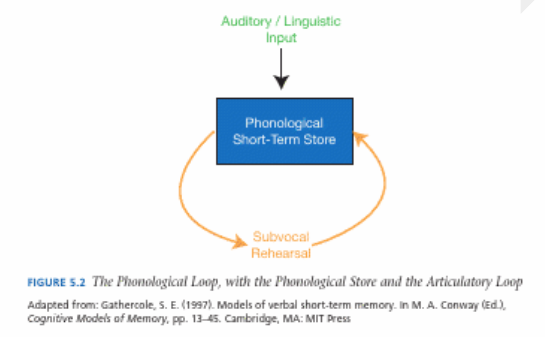
The phonological store is a temporary storehouse, whereas the articulatory loop is for active rehearsal. The way the system works is that information first enters the phonological store. Over time, this information decays and is eventually lost.
How do we prevent the decaying of information in the phonological loop?
To prevent this, the articulatory loop actively rehearses the information in the phonological store, refreshing and preserving it. The more information that is held in the phonological store, the harder the task of the articulatory loop, and the more likely it is that information will degrade to the point that it cannot be recovered and, so, is forgotten.
The basic process from the phonological loop
While we are talking about a phonological loop here, this same basic process is thought to operate for language processing in general, including non-spoken languages such as American Sign Language.
Major effects that have been observed of the phonological loop.
These provide insight into various characteristics of working memory.
The word length effect is the finding that a person’s word span is smaller for longer words than for shorter words. This can be broken down into two types of word length effects.
The first is the syllabic word length effect, which is the finding that it is harder to remember words with more syllables than words with fewer syllables. This occurs because more time is needed to rehearse some items in a set, causing other items not to be refreshed, making them more likely to be forgotten.
The second word length effect is the articulatory word length effect which is the idea that processing can be affected by articulation duration, apart from the number of syllables. In other words, the longer it takes to physically say the words, the fewer that can be recalled. Keeping the number of syllables constant, more short-duration words, such as “wicket” and “bishop,” can be recalled relative to long-duration words, such as “harpoon” and “Friday.”
Example of the irrelevant speech effect:
Trying to read in a room where other people are talking it is difficult to concentrate, because this additional information (the background voices) enters working memory and takes up some resources of the phonological loop, causing other information (your reading) to be harder to process and more likely to be forgotten.
Evidence for the syllabic word length effect
One finding related to the syllabic word length effect is that Chinese speakers have larger digit spans than English speakers, who in turn have larger digit spans than Welsh speakers. This is related to the digit word lengths for those languages. In Chinese the digits are all monosyllables, whereas in English some digit names are multisyllabic, thereby lengthening articulation time. For example “seven” in English, is “qi” in Chinese. Welsh is even worse than English. It has also been shown that the digit spans of Chinese–English bilinguals vary depending on which language people are speaking. Thus, it is not that Chinese speakers are smarter but that they are fortunate enough to have a language with syllabically simpler words for digits.
Evidence for the articulatory suppression effect
The articulatory suppression effect is a reduced verbal span when people are speaking while simultaneously trying to remember a set of items. Talking about one thing makes it very difficult to remember something else. This results in memory span being reduced.
A more everyday example is if someone tells you his or her name and college major at a party while you are talking with someone else, this impedes your ability to rehearse and remember that person’s name and major.
What happens is that an articulatory suppression task, such as repeating the word “the,” takes up resources from the articulatory loop. As a result, information in the phonological store cannot be adequately refreshed and so it is lost from working memory.
the irrelevant speech effect- Salame and Baddeley (1989)
The irrelevant speech effect is the finding that the phonological loop is less efficient when there is irrelevant speech in the background, even if it is in a language people don’t understand. Salame and Baddeley (1989) had students try to learn information either in silence or while listening to either instrumental music or music with vocals.
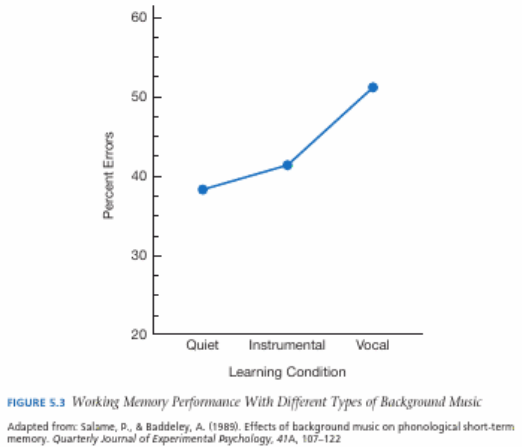
The results show that memory was best when students were in quiet conditions. However, when there was background noise that involved language, such as music with vocals, memory was worse. Listening to instrumental music had a moderate effect. The linguistic nature of the irrelevant speech of the music with vocals interfered with the operation of the phonological loop.
The phonological similarity effect
The phonological similarity effect is the finding that phonologically similar items are more likely to lead to errors. That is, when the words share the same sounds (e.g., “whole,” “bowl,” “boat,” “bone,” and “phone”) people forget more and make more errors than when the words do not share the same sounds (e.g., “whole,” “line,” “milk,” “fire,” and “hunt”). Performance is not as bad when the words in the list rhyme (share the same ending sound), worse when they are alliterative (share the same beginning sound), and worst when both of these are occurring throughout the list. In these circumstances, people are likely to misremember a similar sounding word. For example, if one of the words was “bowl,” people might misremember it as “roll,” which sounds similar but looks different, but not “fowl,” which looks similar but sounds different. In general, this phonological similarity effect occurs because information is degrading in the phonological store.
Reconstruction:
When it is time for an item to be rehearsed, some reconstruction may be needed. Because phonological information is auditory, this reconstruction is based on the fragmentary phono logical information that is available. When there are phonologically similar items, it is harder to keep track of which ones have and have not been rehearsed. This makes it more likely that an unrehearsed item is not refreshed and forgetting occurs. It should be noted that all of these effects do not take into account knowledge in long-term memory, which may be used to support what is happening in working memory.
The lexicality effect
Working memory is influenced by prior knowledge. Memory spans are larger for words than for nonwords. This is the lexicality effect. People use long-term knowledge to support and reconstruct information in the phonological store.
This commonly occurs with poetry and song lyrics. People can draw on knowledge of the sentence along with memory of the rhyme scheme to come up with the appropriate response. Thus, people can use long-term knowledge to aid short term recall.
Phonological loop analogy
A helpful analogy is that the phonological store is like an inner ear, which listens to what we say to ourselves, and the articulatory loop is like our inner voice, which says what we are thinking.
Visuospatial sketchpad
Another working memory subsystem is the visuospatial sketchpad. The visuospatial sketchpad is responsible for processing visual and spatial knowledge. It is responsible for visual information, such as size or colour, and spatial information, such as the relative orientation of entities, or spatially manipulating an object in one’s own head.
Different aspects of the visuospatial sketchpad involve some element of embodied cognition, as if working memory is simulating the world and how a person would interact with it.
Also the visuospatial sketchpad involves more processing from the right hemisphere than the left. This is consistent with the idea that the right hemisphere is dominant for spatial and holistic processing.
Also, the premotor cortex (BA 6) is important for the visuospatial sketchpad’s active processing, as well as portions of the parietal lobes involved in perception.
The tasks of the visuospatial sketchpad and the CRT model
One of the main tasks of the visuospatial sketchpad is the construction, maintenance, and manipulation of mental images that are isomorphically related to perceptual images. The more working memory capacity a person has, the more accurate working memory is for visual characteristics, like colour.
Mental images must be actively rehearsed or they degrade. This is outlined in the CRT model of visual imagery. When you watch television, the image on a screen is not projected all at once. Instead, it is continuously refreshed and then starting over again. The speed is the refresh rate. Thus, even a static image is constantly decaying and being reconstructed. The CRT model of visual imagery assumes that a similar process occurs in the visuospatial sketchpad.
A mental image is constantly decaying and being refreshed. This is also similar to the operation of the articulatory loop. In support of this, like the word length effect, people find it harder to maintain complex rather than simple mental images. The more components to the image, the more elements the visuospatial sketchpad that need to be refreshed and the more opportunity there is for forgetting.
How does the visuospatial sketchpad manipulate information, and toward what aim?
One role is as a surrogate for physical reality. A person might make decisions about objects at two different locations by mental scanning across their mental image. Mental scanning time increases with the distance that needs to be covered. Kosslyn et al had people memorize a map of an island, like this:
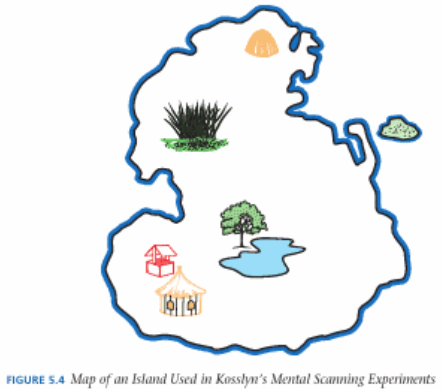
The task was to verify some aspect of one of the island locations.
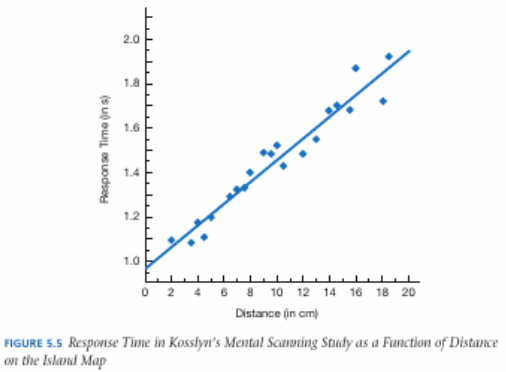
The results reveal that response time increased with the distance from one location to another.
Processing information in the visuospatial sketchpad and Intons-Peterson and Roskos-Ewodlsen
Processing information in the visuospatial sketchpad has isomorphic perceptual qualities similar to what it would be like in reality.
Intons-Peterson and Roskos-Ewoldsen (1989): students did a mental scanning task, using their knowledge of the Bloomington campus. The students were asked to imagine themselves going from one location to another, carrying either a balloon or a load of bricks. In both cases, response time increased with greater distances. Moreover, the increase in response time was greater when the students imagined they were carrying the heavy load rather than the light one. Thus, the operation of working memory can capture aspects of the world in a direct fashion.
Mental imagery processes
Mental imagery processes in working memory rely on similar visual and spatial processes as those used during perception, except that people produce the images themselves rather than having them present in the environment.
Mental rotation
Another visuospatial working memory process is mental rotation, in which people need to mentally turn an object. This might be done so that people can make a decision, such as identifying it. Imagine that a sign that is upside down. You must mentally rotate the letters or numbers to decipher the message. Another possibility is that people may need to compare two objects for some purpose, such as working on a jigsaw puzzle. You mentally rotate the pieces to see if they fit together before actually picking them up and trying them out. Research has shown that, like visual scanning, mental rotation has characteristics that mimic physical rotation. The greater the degree of rotation required, the longer it takes to do the task.
Shepard and Metzler
In a study by Shepard and Metzler (1971), students saw pairs of three-dimensional figures.
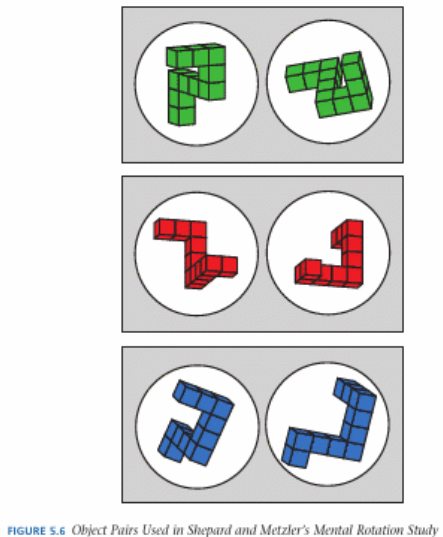
Participants had to say whether the figures were the same or different. These figures could be rotated either in the picture plane (as with the pair on the top) or be rotated in depth (as with the pair in the middle).

The results showed that response time increased with the degree of rotation that was needed. Mental rotation reflects embodied cognition. People mentally rotate as if they were actually turning an object.
What reinforces Shepard and Metzler’s findings
This is reinforced by the finding that if there is unseen tactile feedback, such as feeling the actual object being turned in one’s hand, then performance improves. This benefit is not observed if people simply feel the object and it is not rotated, if a different object is rotated in their hand, or if the rotation is in a different direction.
Finally, mental rotation is easier if the object is easier to rotate in real life, even though all that is being rotated is a thought. In the neurological underpinnings of mental rotation, the parietal lobes tend to be involved, along with support from the frontal lobes.
Furthermore, if the mental rotation is demanding, there may be more involvement of the left hemisphere than the right, suggesting an increase in analytic processing.
Many visuospatial processes involve more right-hemisphere activity when more holistic processing is needed.
Boundary extension
The operation of the visuospatial sketchpad is also observed in the phenomenon of boundary extension, which is memory for details beyond what is seen is boundary extension.
When we view the world we are only getting bits and pieces of it at a time. What gives us the experience of being in a world filled with more visual information than is actually available to us in the moment?
In part, we fill in beyond the edges with what we think should be there. This is especially striking in memory of pictures, television shows, or movies. When you remember a movie, it is unlikely that your memory typically contains the experience of the edge of the screen and the theater beyond that. You remember more of the scene than you actually saw.
Studies of boundary extension- dynamic theory
In studies of boundary extension, people might see a series of photos, such as
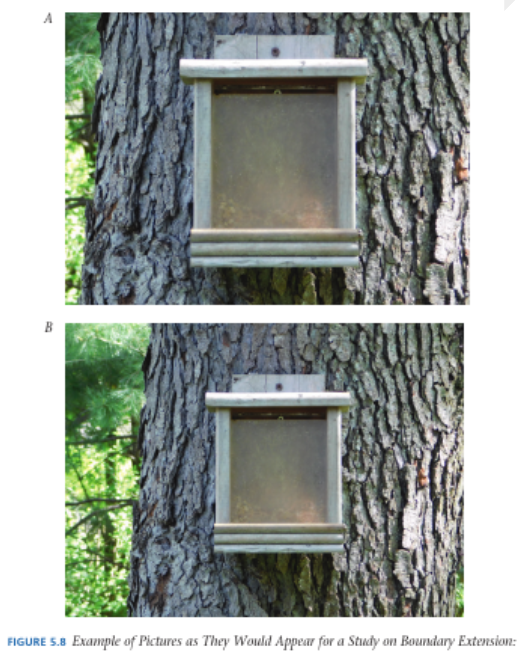
Then, they be given probe pictures to indicate whether each was seen before (old) or not (new). Some would be old, original versions of the pictures. Some shots would be closer up and others taken from further back (thereby extending the boundary of the original). People made more errors by selecting pictures taken from further out. Moreover, if people draw what they saw, they tend to include information beyond the image. People fill in the surrounding space using the visuospatial sketchpad and incorporate this into their memory.
Boundary extension occurs even when images were viewed as briefly as 42 ms. Still, boundary extension is not an automatic process. For it to occur, a person must think that what is being viewed is a scene from the world. There must be some sort of background, even if it is only imagined. Pictures of objects without a background do not produce boundary extension.
Thus, the operation of the visuospatial sketchpad depends on knowledge in long-term memory. If a picture does not activate this knowledge, then no boundary extension occurs. There are other visuospatial sketchpad processes that involve the interpretation of real or perceived motion. Because of this, it is called dynamic memory
BADDELEY’S MULTICOMPONENT THEORY- moving objects
When we watch moving objects and blink or look away briefly, they often continue in motion. This continued motion is captured in the visuospatial sketchpad. Representational momentum is a bias for people to misremember the location or orientation of an object further along its path of travel than it actually was the last time it was seen. It is as if people have difficulty stopping the object in their visuospatial sketchpad. An example of a representational momentum is:
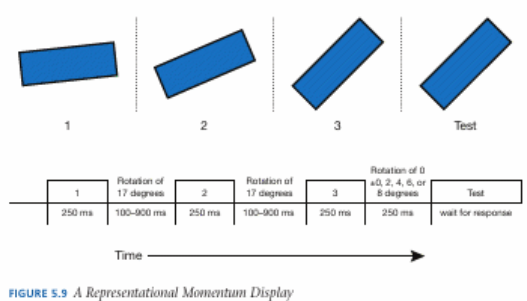
Here, a box appears to be rotating across a series of displays. After the last display there is a delay and people are given a test display. The task is to say whether the object is in the same orientation as it was when it was last seen. These test objects can be the actual last display, a box rotated slightly backward, or a box rotated slightly forward.
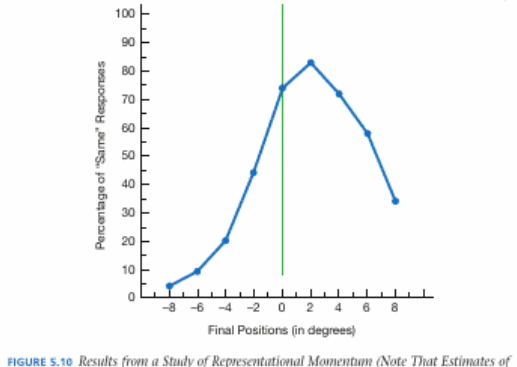
The results reveal a tendency for people to misremember the box as being further along in its rotation than it actually was.
representational momentum
If you see a car moving along a street, and it disappears behind a bush, you would misremember it as being further along its path of travel than it actually was.
Representational momentum is influenced by the object’s speed, with faster objects exhibiting more representational momentum. This effect takes into account regular properties of the world.
Representational momentum also reflects properties like a centripetal force. This involves active processing in the visuospatial sketchpad because the amount of distortion is directly related to the speed of the mental rotation. The faster people mentally rotate, the greater the distortion.
Representational momentum tends to follow medieval impetus theories of motion rather than Newtonian, modern views- even for physics experts.
Thus, this aspect of working memory has only a limited influenced from knowledge in declarative long-term memory. Representational momentum influences are not limited to visuospatial memory, they are also observed with music pitches moving up or down.
Representational gravity and representational friction
Representational gravity is the finding that memory for object positions tends to be distorted toward the earth, especially when the objects are not supported:
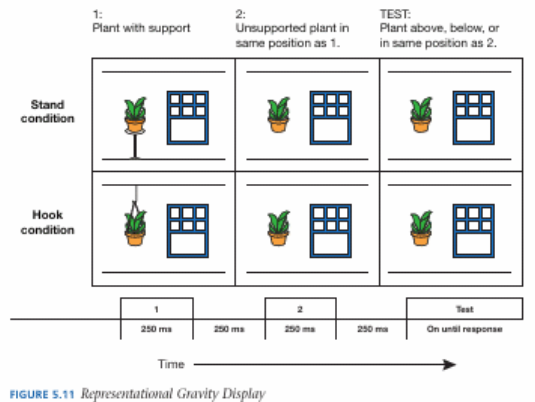
People viewed a plant initially on a table or suspended by a hook.
Then, in a later display, the table or hook was absent. People were tested for their memory of the plant’s location. People tend to remember it as being lower than it actually was.
This is consistent with the idea that representational gravity is influencing the visuospatial memory, moving the plant lower. This image is not in motion, but the motion is implied by gravity.
In general, when static images convey likely interactions among objects, the visuospatial sketchpad infers some type of motion. Similarly, if a circle is seen on an incline, it is remembered as being further down the incline, as if it had rolled. The greater the incline, the greater the distortion.
Visuospatial working memory taking into account physical principles to anticipate what will happen next.
Representational friction is that moving objects slow down more when moving along another object (like the ground) that can produce friction. The greater the implied contact with a surface, the greater the implied friction. In some sense, representational friction puts the brakes on representational momentum.
Overall, people are unconsciously predicting the outcome of events using the visuospatial sketchpad.
episodic buffer and Jefferies, Lambon Ralph, and Baddeley (2004)
The episodic buffer is where multimodal information from different sources is combined together.
Its role is to bind together information from various sources in working memory and long-term memory. This uses the attentional processes and can be disrupted by concurrent tasks.
Jefferies, Lambon Ralph, and Baddeley (2004): people were given either lists of words or sentences with the task of recalling them later. While they were holding these items in working memory, people did a demanding distractor task that consumed central executive resources.
Performance was disrupted on the sentence list task but not the word list task, because sentences require people to bind together the words. With a heavier working memory load, people had difficulty doing this and so performance was hampered.
episodic buffer- Darling and Havelka
Darling and Havelka (2010): people had to remember digits presented one at a time either (1) at a single position on a screen, (2) on a number line, or (3) arranged in a keyboard pattern (such as that found on a telephone).
They found that memory was better in the third condition because when the digits were shown in a keyboard layout people could bind spatial information together with the digit information to better remember the sequence
Central Executive
This is involved in the allocation of attention.
The central executive does most of the work of working memory. If researchers are studying the central executive, they may tie it up by doing something else to see what impact its absence has by giving a task like generating a list of random numbers (which is much harder than it sounds). This causes people to do more poorly on tasks that require active thinking in which control over the flow of information is at a premium.
In some sense, the central executive serves to distribute memory resources. One thing that can improve performance is if there are more resources available. Activity that brings the body to an optimal state of arousal effects working memory performance. This is why you think more clearly when you’ve had enough sleep.
Moreover, active executive processing is resource consuming and can show deficits when resources are low. Also, increasing physical activity increases your working memory performance. That said, after high levels of aerobic activity, explicit memory may be compromised and implicit memory is unaffected.
Dysexecutive syndrome
The disruption of the central executive is seen when there has been brain damage, particularly to the medial frontal lobes, as revealed by EEG recordings.
This can result in a symptom known as dysexecutive syndrome, where people lose some central executive functions that control their thought processes.
With this syndrome, people may exhibit two types of behaviour: perseveration and distraction.
Perseveration:
Perseveration is when people have been doing a task one way and need to do it another way but the switch is not made. For example, if people are first asked to sort a deck of cards by suit, they could do so easily. But if they were then asked to then sort the cards by value, they would continue to sort them by suit. There is a perseveration of the old mode of thinking and people cannot disengage from it to move on to the new way. What is especially odd is that people can report what the correct sorting strategy should be and may admit they are not following the new strategy even as they continue to follow the old one. Relatedly, some behaviours exhibit elements of distraction.
Distraction:
Distraction occurs when people are supposed to be attending to one task but some elements of the environment take attention away from it. For example, if they are not currently processing information, attention might drift and become locked on some other stimulus in the environment. Overall, the dysexecutive syndrome illustrates the attentional control that has been attributed to the central executive. When this component has been damaged, the flow of the stream of thought is disrupted, getting stuck on old processes and drifting out to unrelated areas.
Cowan’s embedded processes model
Another conception of working memory is Cowan’s (1988) embedded processes model.
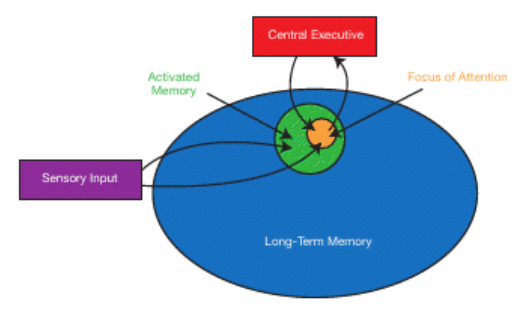
Here, working memory is not a separate part of memory, apart from long-term memory. Instead, working memory is a portion of long-term memory that is in a currently activated state. Working memory is, more simply, the part of a person’s knowledge (as well as incoming information from the environment) that is in a more accessible or active state. Within working memory is the focus of attention, which is those elements that attention is currently directed to. For this view, the focus of attention is about four items. Like Baddeley’s model, there is a central executive, which directs where the focus of attention is to be within the set of memories to those that are in a currently activated state of working memory. Thus, overall, information in the focus of attention is what a person is currently attending to and thinking about at the moment and the larger portion of working memory is composed of information that is readily available to be brought into the focus of attention as needed.
LTM and LTWM
This conception of working memory is also related to the earlier idea of long term working memory. Long-term working memory is a way for people to coordinate large amounts of information. Essentially, long-term working memory is a set of retrieval cues held in working memory that reference information in long-term memory. By using these cues, people can quickly access the information as needed. In some ways, this approach to working memory makes a lot of sense.
memory as a computer
Early theories of memory and cognition were based on the computer metaphor, that is, the idea that the mind works in a way similar to a digital computer. Well, in a computer when information is actively processed, a copy of it is put into an active state, namely in the Random Access Memory (RAM) of the machine. Information enters RAM either through some an input device or from permanent storage, such as a hard drive. It is moved from one part of the machine to another (RAM), where it can be actively worked on (via the CPU). The bits in RAM are flexible and can accommodate any pattern of information. Well, the human brain just does not work this way. While there are different parts of the brain that process information in different ways, there is not a separate part of the brain that brings in information from other parts to be actively processed. There is no part of the brain that is a separate working memory store. Instead, the patterns of neural firing in the various parts of the brain are involved in representing the ideas are active when a person is thinking about them. This is more in line with Cowan’s embedded processes model.
Engle’s controlled attention model
Another working memory theory is Engle’s controlled attention model. Like the embedded process model, there is no separate working memory store, instead, working memory contents are the information that is currently in an activated state from the long term memory.
The key idea in this model is that working memory performance depends on a person’s ability to control attention—specifically, how effectively they can maintain focus on relevant information and resist interference. In this view, cognitive control—the ability to direct and manage attention—is central to working memory functioning
There are two components to attentional control:
(1) the scope of attention (how many things are captured by attention at a time),
(2) the control of attention (how effective is the control over where attention is directed)
control of attention
This control of attention in working memory involves the frontal lobes, particularly the prefrontal cortex. Measures of working memory span do not reflect how much control a person has in processing information in working memory, but rather their attention control ability.
This view accounts for the fact that working memory can be disrupted by irrelevant tactile stimulation (i.e., feeling something crawling on your skin that you don’t expect).
For Baddeley’s multicomponent model there should be a separate system for tactile information, and this should not disrupt processing much in other systems.
The critical factors for Engle’s controlled attentional model
In Engle’s model, the key factor in working memory is not how much information is stored, but how much attentional control a person has. The more attention a task requires or disrupts, the more it affects working memory performance.
Another important influence on working memory is how it interacts with long-term memory. For example, individuals with higher working memory capacity are better at consolidating memories, especially during sleep. This suggests that people with stronger working memory control are also more effective at transferring information into long-term memory.
Additionally, working memory ability is linked to how well people manage interference and retrieve information from long-term memory. Those with higher working memory capacity can retrieve information more accurately and are less affected by interference, such as in the fan effect, where having too many associations with a concept slows down recall.
Kane and Engle
Kane and Engle (2000) found that people with larger working memory span scores showed less proactive interference. Put another way, people with smaller working memory capacities search through a larger set of information during memory retrieval, making their retrieval less efficient. Essentially, greater working memory control allows people to better select out which long-term memories are needed to accomplish a task, thereby reducing any effects of memory interference.
In addition, any activity in your environment can intrude on your long-term memory search. If you have better control over working memory, then this retrieval task is easier compared to people whose memory search drifts more toward inappropriate memories and environmental stimuli.
Suppression
Suppression is an attention mechanism that memory can use to control what is being currently thought about. Suppression keeps irrelevant information out of working memory or removes information that has become irrelevant or inappropriate. Thus, the suppression of irrelevant information is an important determinate to effective working memory processing. The operation of suppression is closely tied to the prefrontal cortex.
Neuroimaging findings
The idea that different aspects of working memory, in terms of the control of processing, is supported by neuroimaging findings. Using event-related synchronization (ERS) and event-related desynchronization (ERD) analyses of EEG data, it has been found that different aspects of working memory processing are observed in different wavebands. Gamma band synchronization reflects the maintenance of information, alpha band synchronization reflects the control of attention and inhibitory processes, and theta band activity reflects the sequencing of information.
suppression- Johnson et al. (2013)
Johnson et al. (2013).
First, they showed 29 students two words on a screen for 1.5 seconds. Then there was a blank screen for half a second followed by screen, for 1.5 seconds, of an arrow that pointed to one of the two words. The task was to say what the word at that location was. Then, after a delay, people were shown a target word, which could be (1) the word just said (refreshed), (2) the other word from the display (unrefreshed), or (3) a new word (control). The task was to say the probe word as quickly as possible. There were 144 trials, with 48 trials in each of these three conditions. The primary data of interest is the response times for people to say the word at the end of each trial. Because spoken responses were used, the researchers had to throw out any trials where a person misspoke, spoke too quietly to trigger the device, or made nonspeech sounds.
People were slower to say the target word if they had just said it in response to the arrow cue than if it was the other word they had seen (people were slowest in saying a new word).
This suggests that when working memory processes something and then moves on to the next task it actively inhibits or suppresses the memory for what was just processed. This may occur because the just-processed information is typically not needed for a new task, and people are more effective if the newly irrelevant information is removed from working memory.
